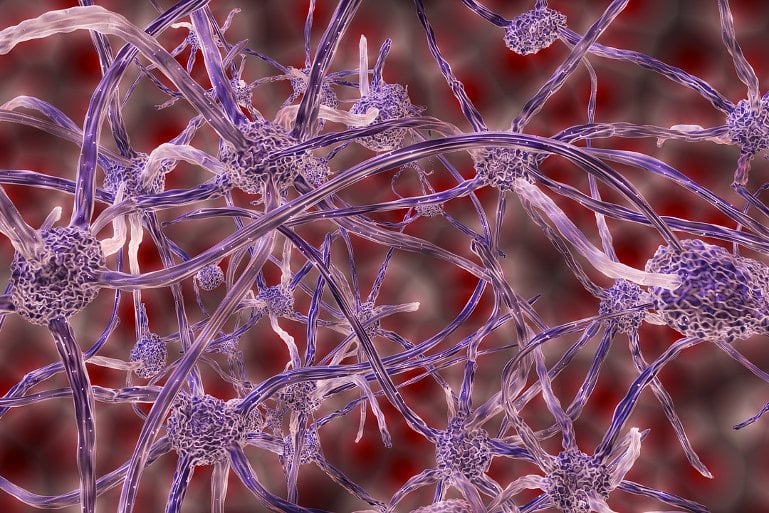Summary: High-frequency repetitive transcranial magnetic stimulation (rTMS) activates MAP2K signaling and enhanced axon regeneration and functional recovery following spinal cord injury.
Source: BNI
A new study by Burke Neurological Institute (BNI), Weill Cornell Medicine, finds that activation of MAP2K signaling by genetic engineering or non-invasive repetitive transcranial magnetic stimulation (rTMS) promotes corticospinal tract (CST) axon sprouting and functional regeneration after spinal cord injury (SCI) in mice.
rTMS is a noninvasive technique that evokes an electrical field in brain tissue via electromagnetic induction. While an increasing body of evidence suggests that rTMS applied over motor cortex may be beneficial for functional recovery in SCI patients, the molecular and cellular mechanisms that underlie rTMS’ beneficial effects remains unclear.
A new study published in Science Translation Medicine showed that high-frequency rTMS (HF-rTMS) activated MAP2K signaling and enhanced axonal regeneration and functional recovery, suggesting that rTMS might be a valuable treatment option for SCI individuals.
Facilitating axon regeneration in the injured central nervous system (CNS) remains a challenging task. The failure of mature CNS neurons to activate cell-intrinsic growth mechanisms and regenerate injured axons severely hinders the development of effective new therapies after a traumatic brain or spinal cord injury.
The RAF–Mitogen-activated protein kinase kinase (MAP2K, also known as MEK) signaling cascade mediates long distance axon outgrowth in developing PNS and CNS neurons. Based on their previous findings, researchers from BNI hypothesized that RAF signaling regulates an intrinsic axon growth program and that its activation could enable re-growth of adult mammalian CNS axons after SCI.
They found that conditional expression of a constitutively kinase-activated BRAF in mature corticospinal neurons (CSNs) elicited the expression of a set of transcription factors previously implicated in the regeneration of zebrafish retinal ganglion cell axons.
In addition, conditional BRAF activation in CSNs enabled CST axon sprouting and regeneration in different experimental models of SCI in mice. According to Xiaofei Guan, MD, Ph.D., a postdoctoral research fellow at BNI who conducted the experiments, newly sprouting CST axons formed synapses with local spinal circuits and further resulted in improved motor functional recovery.
rTMS has been emerging as a promising strategy to enhance recovery in patients with spinal cord or brain injury, but the underlying plasticity mechanisms and the full therapeutic potential of these approaches remain unknown.

The BNI research team found that a course of daily high-frequency rTMS sessions activated MAP2K signaling and modulated the expression of a set of regeneration-related transcription factors in the same way as genetic BRAF activation. Endogenous MAP2K activity was required for enhanced CST sprouting, regeneration and functional recovery in HF-rTMS treated SCI model mice.
The researchers believe these results collectively demonstrate a central role of MAP2K signaling in augmenting the growth capacity of mature CSNs, and suggest that HF-rTMS might have potential for treating spinal cord injury by modulating MAP2K signaling.
The BNI team has begun clinical trials testing the HF-rTMS protocol on able-bodied individuals and SCI patients. If successful, HF-rTMS could emerge as a non-invasive, low risk treatment option to facilitate axon regeneration, alone or in combination with other additional interventions, for SCI or other individuals who may benefit from CNS circuitry repair.
About this spinal cord injury research news
Author: Press Office
Source: BNI
Contact: Press Office – BNI
Image: The image is in the public domain
Original Research: Open access.
“Activation of MAP2K signaling by genetic engineering or HF-rTMS promotes corticospinal axon sprouting and functional regeneration” by Francesco Boato et al. Science Translational Medicine
Abstract
Activation of MAP2K signaling by genetic engineering or HF-rTMS promotes corticospinal axon sprouting and functional regeneration
Facilitating axon regeneration in the injured central nervous system remains a challenging task. RAF-MAP2K signaling plays a key role in axon elongation during nervous system development.
Here, we show that conditional expression of a constitutively kinase-activated BRAF in mature corticospinal neurons elicited the expression of a set of transcription factors previously implicated in the regeneration of zebrafish retinal ganglion cell axons and promoted regeneration and sprouting of corticospinal tract (CST) axons after spinal cord injury in mice.
Newly sprouting axon collaterals formed synaptic connections with spinal interneurons, resulting in improved recovery of motor function.
Noninvasive suprathreshold high-frequency repetitive transcranial magnetic stimulation (HF-rTMS) activated the BRAF canonical downstream effectors MAP2K1/2 and modulated the expression of a set of regeneration-related transcription factors in a pattern consistent with that induced by BRAF activation. HF-rTMS enabled CST axon regeneration and sprouting, which was abolished in MAP2K1/2 conditional null mice.
These data collectively demonstrate a central role of MAP2K signaling in augmenting the growth capacity of mature corticospinal neurons and suggest that HF-rTMS might have potential for treating spinal cord injury by modulating MAP2K signaling.






